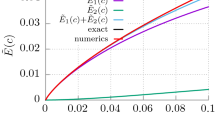Abstract
The Brownian motion of small particles interacting with a field at a finite temperature is a well-known and well-understood phenomenon. At zero temperature, even though the thermal fluctuations are absent, quantum fields still possess vacuum fluctuations. It is then interesting to ask whether a small particle that is interacting with a quantum field will exhibit Brownian motion when the quantum field is assumed to be in the vacuum state. In this paper, we study the cases of a small charge and an imperfect mirror interacting with a quantum scalar field in (1 + 1) dimensions. Treating the quantum field as a classical stochastic variable, we write down a Langevin equation for the particles. We show that the results we obtain from such an approach agree with the results obtained from the fluctuation-dissipation theorem. Unlike the finite temperature case, there exists no special frame of reference at zero temperature and hence it is essential that the particles do not break Lorentz invariance. We find that that the scalar charge breaks Lorentz invariance, whereas the imperfect mirror does not. We conclude that small particles such as the imperfect mirror will exhibit Brownian motion even in the quantum vacuum, but this effect can be so small that it may prove to be difficult to observe it experimentally.
Similar content being viewed by others
REFERENCES
R. K. Pathria, Statistical Mechanics (Pergamon, Oxford, 1972), Secs. 13.3 and 13.4.
F. Reif, Fundamentals of Statistical and Thermal Physics (McGraw-Hill, New York, 1965), pp. 560–567.
J. D. Jackson, Classical Electrodynamics, 2nd Edn.. (Wiley, New York, 1962).
H. B. Callen and T. A. Welton, Phys. Rev. 83, 34 (1951).
R. Kubo, Rep. Prog. Phys. 29, 255 (1966).
P. W. Milonni, The Quantum Vacuum (Academic, Boston, 1994).
L. D. Landau and E. M. Lifshitz, Statistical Physics, Part I (Course of Theoretical Physics, Vol. 5), 3rd edn. (Pergamon, Oxford, 1980).
P. Roman, Quantum Field Theory (Wiley, New York, 1969).
N. D. Birrell and P. C. W. Davies, Quantum Fields in Curved Space (Cambridge University Press, Cambridge, 1982).
W. H. Zurek, Ann. N. Y. Acad. Sci. 480, 89 (1986).
W. G. Unruh and W. H. Zurek, Phys. Rev. D 40, 1071 (1989).
B. DeWitt, Phys. Reps. 19C, 297 (1975).
S. A. Fulling and P. C. W. Davies, Proc. Roy. Soc. Lond. A 348, 393 (1976).
L. H. Ford and A. Vilenkin, Phys. Rev. D 25, 2569 (1982).
Gilad Gour, Motion in the Quantum Vacuum, M.Sc. Thesis, Hebrew University, Jerusalem, Israel, 1998.
J. J. Sakurai, Modern Quantum Mechanics (Addison-Wesley, Reading, Massachusetts, 1994), 84–87.
P. W. Milonni, Phys. Lett. A 82, 225 (1981).
W. C. Saslaw, Gravitational Physics of Stellar and Galactic Systems (Cambridge University Press, Cambridge, 1985), Chap. 3.
A. O. Caldeira and A. J. Legget, Physica 121 A, 587 (1983).
Rights and permissions
About this article
Cite this article
Gour, G., Sriramkumar, L. Will Small Particles Exhibit Brownian Motion in the Quantum Vacuum?. Foundations of Physics 29, 1917–1949 (1999). https://doi.org/10.1023/A:1018846501958
Issue Date:
DOI: https://doi.org/10.1023/A:1018846501958



